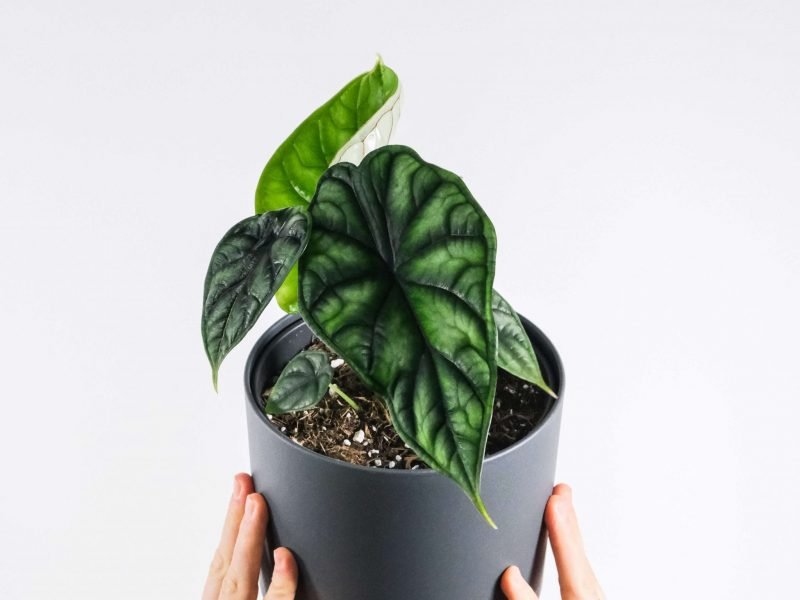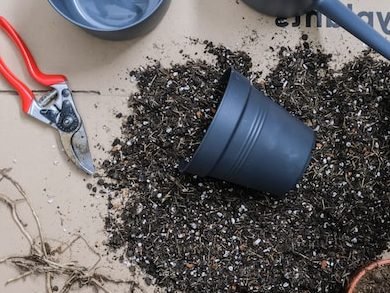
Alocasia Dragon Scale can be pretty hard to come by so when they start losing some of their leaves, it can be pretty worrying! If your Alocasia Dragon Scale is losing the odd leaf here and there then it might just be caused by the natural ageing process, where plants lose some of their oldest leaves in favour of growing new larger ones. However, if the rate of leaf drop is quite rapid, or is increasing, then there is definitely something wrong with the care or environment.
Below we will go through each of the main reasons why Alocasia Dragon Scale plants lose their leaves, so you can figure out what is wrong with your plant and how to go about treating the issue and preventing it from damaging your plant any further.
Shock and Stress can cause temporary leaf drop
You may think that only cold temperatures can shock your Alocasia Dragon Scale but there are some other factors that can cause them stress. In fact, moving your plant to a new spot in your home (or a new home), as well as repotting and propagation can all cause your plant to be a little stressed. They are a little bit like humans in that respect!
If your Alocasia Dragon Scale is a bit stressed out then this might be causing them to lose a few leaves. It shouldn’t be a major leaf drop, only a few depending on the size and maturity of the plant. This shock should wear off after a few days and as long as the environment is right for your plant, you shouldn’t see any continuous leaf drop. Keep an eye on the rate of leaves falling off your plant to check that it’s not increasing.
If the problem persists for a few weeks after moving or repotting your Alocasia Dragon Scale and your plant is still losing leaves, then you may need to check the soil for any damaged roots and monitor how much light it is getting throughout the day to find another reason.
Overwatering can cause leaves to fall off
As with a lot of things in the houseplant world, proper watering can be one of the biggest issues and it is one of the most common reasons why Alocasia Dragon Scale plants lose their leaves.
We always tend to go for a little and often view towards watering and this is especially the case with Alocasia Dragon Scale plants as they like to have some moisture in the soil. It’s a real balance between not over or underwatering and it can be quite tricky to get right.
If your Alocasia Dragon Scale is getting too much water consistently, then this will eventually cause the roots to rot. This means the leaves will start to fall off and the whole plant becomes quite unstable and soft.
If you suspect overwatering, take your plant out of its pot and see how much moisture is in the soil. If your suspicions are right and your Alocasia Dragon Scale is suffering from waterlogged soil, replace it immediately with fresh, dry, well-draining potting mix. You can also use a moisture meter to see when your Alocasia Dragon Scale needs watering. You just pop them into the soil and it’ll show you how damp or dry the potting mix is.
Another thing you can do to avoid overwatering is use a self-watering pot or self-watering globes. They release water to your Alocasia Dragon Scale only when it needs it. They are great for going on holiday too so a good investment for every plant parent.
Underwatering can also cause leaf drop
On the other scale to overwatering, if your Alocasia Dragon Scale has consistently bone dry soil, then the roots will crisp up and the leaves will fall off your plant. Once the root system is damaged (whether that be too much or too little water), it means your plant can’t sustain its healthy growth and it will need to lose leaves to stay alive. Alocasia Dragon Scale plants will forgive you if you occasionally forget to water them but they will struggle with dry soil for weeks and weeks.
It’s important to ensure that your Alocasia Dragon Scale is actually being underwatered before you change anything about your care routine. As you’ve seen above, overwatering can also cause leaves to fall off your plant (and spoiler alert, it can cause a whole range of other issues beyond that too) so you don’t want to start watering it more if it doesn’t need it.
To confirm that underwatering is causing your Alocasia Dragon Scale to lose leaves, take your Alocasia Dragon Scale out of the pot to inspect how the potting mix feels. If underwatered, the potting mix will fall apart and feel very sand-like. If the problem has been going on for a while (which leaf drop suggests), then you should also be able to see some of the roots crisping up.
If this is the case, slowly reintroduce water to your plant rather than drowning it (as you now know, they can go into shock if there is a sudden change in environment). A little bit of water once a day for a week should get your Alocasia Dragon Scale back on track and prevent it from losing any more leaves. In future, adjust your watering schedule so you are watering your plant more frequently!
Natural ageing
If it’s only the oldest bottom leaves on your Alocasia Dragon Scale that are falling off, then this may be natural ageing. As your plant matures, your Alocasia Dragon Scale will drop the occasional leaf to prioritise its efforts on growing new bigger leaves. This is a natural process and happens to most houseplants so is nothing to be concerned about.
We do recommend keeping track of how many leaves your Alocasia Dragon Scale is losing. It should only be a couple every few months. If your plant is losing more than this, or the rate of leaves falling off is increasing, then this suggests there is something wrong with your Alocasia Dragon Scale, most likely watering issues. We would revisit the issues listed above to see what is wrong with your plant.
Those are the most common problems that can cause your Alocasia Dragon Scale to lose leaves. Luckily, a little bit of stress of natural ageing is nothing to worry about but it’s important that you treat any watering issues immediately before they kill your plant completely.
If the issue has progressed as far as leaves falling off then it does mean the problem has been going on for quite a while and getting your plant back to tip-top health might be quite a challenge. But don’t give up, we have seen plants bounce back from having just one leaf, sometimes even just a node so, with the right care and environment, you should be able to revive your Alocasia Dragon Scale.
Check out our Alocasia Dragon Scale care guide for more information on how to best care for your plant.















